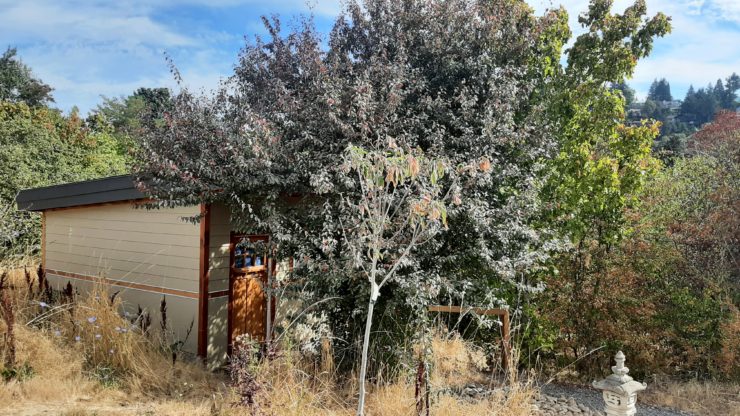On the Daigen Shuri Ceremony
Kakumyo wrote a description of one of our newest ceremonies, Daigen Shuri, which occurs right after our Fusatsu ceremonies, around the solstices and equinoxes.
The most recent addition to Dharma Rain’s liturgy is the Daigen Shuri ceremony. This ceremony is done four times a year, following our Fusatsu ceremony, which happens on a Saturday evening close to the solstices and equinoxes. This article is meant to whet your interest, as these paired ceremonies are coming up on the 25th of September.
We created this ceremony because the sense of place and the sacredness that can be accessed by being in touch with place have become a more prominent part of Dharma Rain’s teaching and practice. In Japan and China, temples are strongly associated with particular places, including the natural features (most temples are associated with a mountain) and deities of that place. As the temple has grown roots on NE Siskiyou, that sense of place has grown and it seemed like there was a need for it to be made more explicit. This idea grew from conversations amongst the temple officers, who meet monthly to discuss trends, needs, concerns and ideas that affect the practice of our sangha.

The ceremony takes place in the Grass Hut (named after Sekito Kisen’s poem, because it has an eco-roof), a small structure which is at the edge of the ravine by the playground and ringed by trees. Participants process in, make bows, chant a chapter from the Lotus Sutra (the Parable of the Medicinal Plants), and the Sho Sai Myo Kichigo Dharani. During chanting the incense box is passed around to all. After the chanting, there is an offertory that sends merit to Prajnaparamita, Daigen Shuri, and other protective and teaching spirits of the land. The offertory also includes an acknowledgement of the indigenous inhabitants of this land.



The primary devotional image in the Grass Hut will be Shin’ei’s painting of Prajnaparamita, the mother of all Buddhas and perfection of wisdom, emphasizing her earth mother aspect. Shin’ei, who is now practicing at Buddha Eye temple in Eugene, has been working on this piece for over a year. Some pictures of the work she’s done so far are included above.
Daigen Shuri (the statue featured above) was included in the ceremony as the most obvious Soto Zen protective figure. He is often depicted looking out over a vast distance with his hand shielding his eyes, symbolizing the awareness of all the Soto temples he is watching out for. He was probably originally a Shinto deity associated with safe passage at sea, who was absorbed by Zen as it grew in Japan, and is sometimes seen as a bodhisattva, and sometimes as one of the dharma-protecting deities.
This assimilation of local deities is common, it’s one reason we have Fudo enshrined in the main hall (to Manjushri’s right), instead of Samantabhadra, which would be more traditional. Sojiji, the monastery that Jiyu Kennett trained at in Japan, was built on the site of an old Fudo shrine, and so gave Fudo a place of honor in the hall, which was continued at Shasta, and Dharma Rain.
The full seijo (ceremony description) is available below. We hope you’ll join us!
